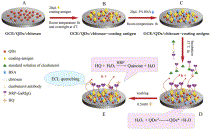Xun Yaoa, b, Panpan Yana, b, Qinghui Tanga, b, Anping Denga, b*(邓安平), Jianguo Lia, b*(李建国)
a College of Chemistry, Chemical Engineering & Materials Science, Soochow University, Suzhou 215123, China
b The Key Lab of Health Chemistry & Molecular Diagnosis of Suzhou, Suzhou 215123, China
Ana. Chim. Acta 2013, 786, 82-88
An ultrasensitive electrochemiluminescence (ECL) immunosensor based on CdSe quantum dots (QDs) has been designed for the detection of clenbuterol. The immunosensor was fabricated by layer by layer and characterized with atomic force microscopic images (AFM) and electrochemical impedance spectra (EIS). In oxygen-saturated pH = 9.0 Tris-HCl buffer, a strong ECL emission of QDs could be observed during the cathodic process due to the H2O2 product from electrochemical reduction of dissolved oxygen. Upon the formation of immunocomplex, the second antibody labeled with horseradish peroxidase was simply immobilized on the electrode surface. The ECL emission decreased since steric hindrance of the immunocomplex slowed down the electron-transfer speed of dissolved oxygen, and also could be greatly amplified by an enzymatic cycle to consume the self-produced coreactant. Using clenbuterol as model analyte, the ECL intensity was determined by the concentration of competitive immunoassay of clenbuterol with a wide calibration in the range of 0.05 ng mL−1 to 1000 ng mL−1, and a low detection limit was 0.02 ng mL−1. The immunosensor shows good stability and fabrication reproducibility. It was applied to detecting practical samples with the satisfactory results. This immunosensing strategy opens a new avenue for detection of residue and application of QDs in ECL biosensing.

链接: //www.sciencedirect.com/science/article/pii/S0003267013011215